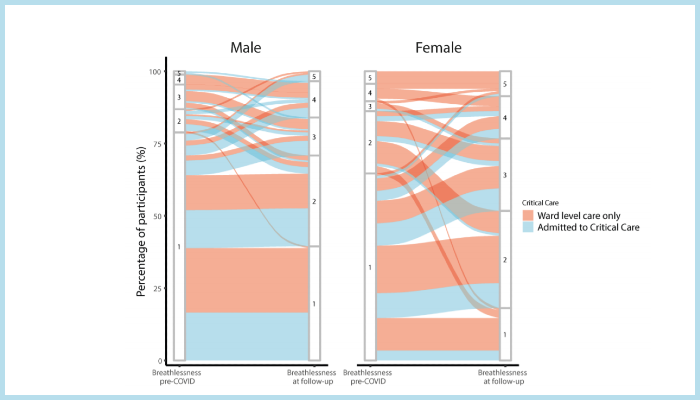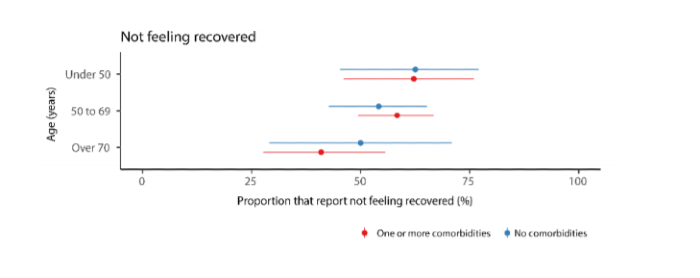WOMEN UNDER 50 HAD WORSE LONG-TERM OUTCOMES AFTER COVID-19
Published: 25 March 2021
Women under 50 and people who had experienced severe disease had worse long-term outcomes following hospitalisation with COVID-19, according to research led by the Centre for Virus Research's Dr Janet Scott.

Women under 50 and people who had experienced severe disease had worse long-term outcomes following hospitalisation with COVID-19, according to research led by the Centre for Virus Research's Dr Janet Scott.
This, the first long-term follow-up data from the International Severe Acute Respiratory and emerging Infections Consortium (ISARIC) Clinical Characterisation Protocol study from the UK, shows that, in adults who were admitted to hospital, nearly all experienced ongoing symptoms three months or more after the onset of their infection.
Led by the University of Glasgow in collaboration with the Universities of Oxford, Liverpool, Edinburgh and Imperial College London, and working with ISARIC's global Covid-19 follow-up working group, the research found that adult women under the age of 50 had higher odds of worse long-term health outcomes when compared with men and older study participants, even if they had no previous co-morbidity.
People with more severe acute disease in hospital also had worse long-term outcomes than those who did not require oxygen. Overall, more than half of all the participants reported that they had not fully recovered three months after the onset of Covid-19 symptoms.
Researchers followed 327 adults from 31 hospitals around the UK who had been admitted to hospital between 5 February 2020 and 5 October 2020 for at least three months, and up to 11 months, in order to document their physical health, and impact on psychological health and quality of life.
After their acute COVID-19 illness, female participants under the age of 50 years old were five times less likely to report feeling fully recovered. Moreover, they were twice as likely to report worse fatigue, were seven times more likely to be more breathless and were more likely to have worsening difficulties or a new disabilities, especially relating to memory, mobility, communication, vision, hearing and self-care than men of the same age.
Overall, 55 per cent of participants reported that they did not feel fully recovered. In addition, ongoing symptoms were reported by 93 per cent of participants, with fatigue the most common, reported by 83 per cent, followed by breathlessness, which was reported by 54 per cent of people, many also experienced muscular pain and discomfort.

Lead author Dr Janet Scott, Clinical Lecturer in Infectious Diseases at the CVR, said: “Our research shows that survivors of COVID-19 experienced long-term symptoms, including a new disability, increased breathlessness, and a reduced quality of life.
"These findings were present even in young, previously healthy working age adults, and were most common in younger females.
“The fact that women under the age of 50 are the group with the worst outcomes could have profound implications for pandemic policy decision, as well as vaccination strategy.”
Margaret O’Hara, of the patient group Long COVID Support, said “This research is important because it shows that just because people have been discharged from hospital it doesn’t mean that they have recovered from COVID.
"Long COVID support have worked closely with the research team to develop the questionnaire for this study to make sure that the incidence of Long COVID is properly recorded.
“The tens of thousands of people using online-support forums for long COVID are desperate for research that can help them get their lives back.
"Research such as this is crucial to understand the true incidence of Long COVID and the huge impact it has on people’s lives so that proper services can be developed to meet their needs.”
Louise Sigfrid, of the ISARIC Global Support Centre, University of Oxford, said: “This is an important first step and part of a wider harmonised international effort to better understand Long COVID.
"We have sister projects running in 15 countries in Europe, South America, Africa, Asia and the Middle East, to forward our understanding of Long Covid, including identifying people at increased risk for developing Long covid, to inform preventative strategies, interventional studies and targeted support to improve outcomes.”
Professor Calum Semple, Professor of Child Health and Outbreak Medicine at the University of Liverpool and chief investigator of ISARIC 4C, said: “ISARIC uses prepared protocols and harmonised data tools to conduct timely research in outbreaks.
"This prospective cohort study of UK COVID survivors is an important first step in defining the spectrum of Long COVID.
"We found that the most severely affected people are women of working age and the continued to experience a range of disabling problems long after discharge from hospital.”
Dr Tom Drake, Clinical Research Fellow at the Usher Institute, University of Edinburgh, said: “It is becoming increasingly clear that COVID-19 has profound consequences for those who survive the disease.
"In our study, we found that younger women were most likely to have worse long-term outcomes. It's really important that people living with the consequences of COVID-19 get the right support they need.
"Governments, both in the UK and across the world, need to think about the impact this will have in the long term and fund urgent research to find treatments for long COVID.”
Long Covid in adults discharged from UK hospitals after Covid-19: A prospective, multicentre cohort study using the ISARIC WHO Clinical Characterisation Protocol
- Louise Sigfrid, Thomas M Drake, Ellen Pauley, Edwin C Jesudason, Piero Olliaro, Wei Shen Lim, Annelise Gillesen, Colin Berry, David J Lowe, Joanne McPeake, Nazir Lone, Daniel Munblit, Anna Casey, Peter Bannister, Clark D Russell, Lynsey Goodwin, Antonia Ho, Lance Turtle, Margret O’Hara, Claire Hastie, Chloe Donohue, Rebecca Spencer, Cara Donegan, Alison Gummery, Janet Harrison, Hayley Hardwick, Claire E Hastie, Gail Carson, eLaura Merson, eJ Kenneth Baillie, Peter JM Openshaw, Ewen M Harrison, Annemarie B Docherty, Malcom G Semple, Janet T Scott.
Image legend
- Figure 4C (above, top): MRC Dyspnoea scale prior to Covid-19 onset and at the time of follow-up. For females, there are greater numbers of participants who begin at MRC 1 and transition to higher levels on the scale compared with males
- Figure 3A (above) A graph showing outcomes stratified by age and presence of one or more comorbidities. Proportion of participants not feeling fully recovered
This paper, available as a pre-print, was tabled at a meeting of the Scientific Advisory Group for Emergencies (SAGE) on 25 February 2021.
Funding: The work was funded by the National Institute for Health Research (NIHR), the Medical Research Council, Wellcome and the Bill and Melinda Gates Foundation
First published: 25 March 2021

